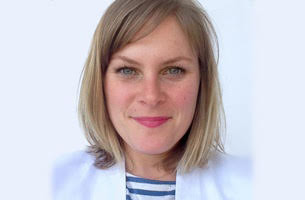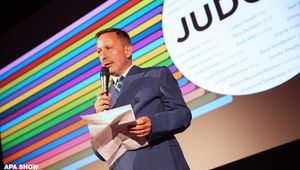
Carbon Emissions and Production: the Magic Numbers

Yesterday I read ‘Arctic warming: scientists alarmed by 'crazy' temperature rises’. I wasn’t going to write about this year’s APA Masterclass session, but after reading that terrifying article, I decided it was worth sharing what I spoke about earlier this month. My AdGreen mission this year is to have people understand how carbon is related not only to climate change, but also to what we do within advertising production. This will help us all to reduce it - and save money in the process. The Masterclass was my first chance to get people thinking about these ideas and I wasn’t about to waste it.
Just as in the previous two years, after a brief introduction to AdGreen, I wheeled out my ‘Climate Change in 60 Seconds’ video. Current scientific consensus is that we need to stay well below a temperature increase of two degrees celsius if we don’t want even bigger changes to life as we know it. As the video explains, we started measuring the temperature of the earth’s atmosphere in the early 1800s, when we started to burn fossil fuels instead of wood during the industrial revolution. Currently we’re just above one degree of warming, which we hit at the end of 2015. If we carry on as we are, we’ll likely hit 1.5 degrees around the 2050s-60s (just as we see the arctic ice disappearing in summer).
The goal of the Paris Agreement (put together in late 2015) is to limit warming to two degrees. However, the consensus of scientists tells us that the pledges put forward by the 194 countries who’ve ratified the agreement will only limit warming to an average of somewhere between three and four degrees. It’ll be reviewed every five years so there are chances to update the pledges, with the goal of steering back towards the magic number.
What does that mean for the UK? The Climate Change Act (2008) requires that by 2050, total UK emissions must fall by at least 80% compared to 1990 levels. We’re actually doing quite well - we’re currently down 46%, and this hasn’t damaged the growth of our economy. In fact, it’s given rise to exciting new industries such as renewable power and electric cars (and the advertising that comes with them!). However, everything we’re doing needs to happen faster, and as the scientists tell us, our contribution in reductions is still not going to be enough to limit the planet’s warming. No diesel by 2040? Ending avoidable plastic waste by 2042? Come on… we can do this quicker can’t we?! The time is now for businesses and industries to set ambitious goals and encourage these big changes sooner.
Before we do that however, it’s important to understand which of the things we do has the biggest impact on the environment. In order to do this we carbon footprint. We talk in terms of carbon because it’s a unit that everything can be converted into, no matter what type of emission or greenhouse gas (GHG) we’re talking about. It’s generally talked about in kilos or tonnes (1000 kilos). The average European’s carbon footprint is 10 tonnes per person per year, but in the UK it’s actually around 16 tonnes. And by 2050, that will need to come down to between two and three tonnes per person per year to get that 80% reduction we need.
Everything we do that is powered by fossil fuels has a carbon output. Alternatively, if we power these actions with a fuel that is renewable, like wind or solar, they have no carbon output. Travel in a diesel fuelled Ford Galaxy for example, and you’re outputting 35g of carbon emissions per mile. Doesn’t sound like much, but multiply that by 10 (let’s say client, agency, a couple of cast, and the director), each taking a 25 mile round trip to the shoot, and you’re looking at 87.5kg, just for that small part of a production. Now imagine running your 160kW genny carrier at full load for 10 hours on location, that’s 1,142kg, or 1.14 tonnes. And what about one return flight from London to Cape Town in business? A whopping 7,784kg, or 7.78 tonnes (the same flight in economy is approximately a third of this BTW). You can see how it quickly adds up, and which are the heaviest hitters.
Our friends at BAFTA’s albert have an online carbon calculator, which most UK TV productions are now using and they have been collecting footprint data for around five years. They know that for one hour of content produced, the average amount of carbon emitted in its production is almost 14 tonnes. Their data covers a whole range of programmes, from studio-based magazine shows like The One Show, right up to international factual and large scale dramas. To give that 14 tonne figure some context, the independent production community make 20,000 hours of TV a year, which equates to about 280,000 tonnes of carbon a year. That will be responsible for the disappearance for 840,000 cubic meters of arctic ice. No small amount, and it brings me neatly back to that terrifying article.
What am I trying to say here? We need to start seeing the link between carbon and money. That is how we’ll be able to sell in these changes higher up the chain and reduce the industry’s impact. Just take the three examples I gave earlier. Public transport will result in taxi savings, and a smaller amount of emissions. Working with your lighting team to reduce the power requirements on your generator will mean you can hire a smaller one, and use less fuel (producing less emissions!). Local crew in Cape Town will be much cheaper than flying out your DOP. Or better yet, shoot closer to home, or even, at home at the right time of year.
During the Masterclass session I gave each table a couple of sections of a typical budget template and asked them to try and make the links between each line’s monetary value and its carbon output. It was generally understood that in reducing the amount of something that was needed, whether it be cars or water bottles, there was a reduction in both total cost and carbon. In the last year, productions that worked with albert’s calculator (and their certification scheme, albert+) saved in excess of £800,000!
Later this year we’re hoping to work on a budget based carbon calculator for production companies to use, based on DEFRA’s carbon factors, which are updated yearly. This should give us all a better understanding of how the two things are related, and where the biggest carbon (and money) savings can be made. New technologies will help of course, and we’re keeping a close eye on electric car development, as well as large-scale electric batteries that can be used to power things on set.
One thing you could do right now? Switch to renewables. If you’d like to switch we can help you, just fill out your details here and we’ll put you in touch with the Creative Energy team at albert, who are collaborating with Good Energy to secure group discounts on renewable energy tariffs.
As we move through 2018, let’s all try thinking in carbon terms, and about what we can do to reduce our industry’s footprint.
Jo Coombes is founder of AdGreen











